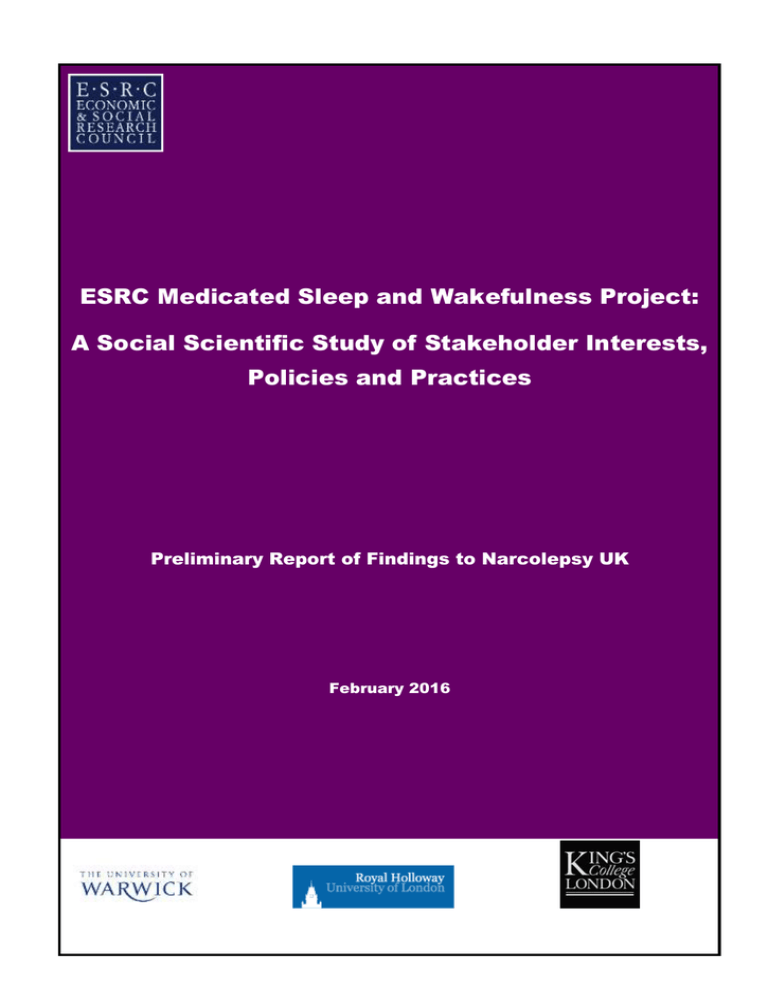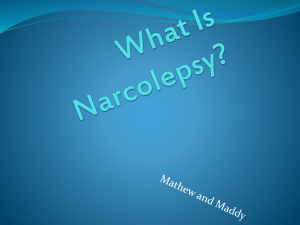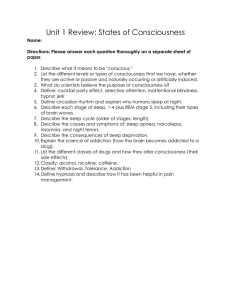ESRC Medicated Sleep and Wakefulness Project: Policies and Practices
advertisement

ESRC Medicated Sleep and Wakefulness Project: A Social Scientific Study of Stakeholder Interests, Policies and Practices Preliminary Report of Findings to Narcolepsy UK February 2016 1 Contents Introduction About the project The participants What we asked Preliminary Findings Introduction Narcolepsy is a neurological condition that is characterised by excessive daytime sleepiness and irresistible sleep episodes or “sleep attacks”. Patients may also experience hallucinations, sleep paralysis and cataplexy (sudden loss of muscle tone mostly triggered by a heightened emotional state such as laughter or anger). Narcolepsy is characterised by fragmented sleep throughout the day and night, so often people with narcolepsy fall asleep and nap during the daytime and also during the night find it difficult to have a consolidated block of sleep. Psychological and social complications of narcolepsy appear to be widespread and potentially severe. However, the topic has been relatively neglected and there have been calls for more studies in this area (Stores, 2010). Excessive daytime sleepiness and cataplexy often interfere with time spent socializing with others as well as the patient’s ability to effectively complete tasks at work and at home (Monderer et al, 2010). These features of the disorder may be disabling and can often lead to relationship problems with employers, co-workers, family members and partners. Educational and employment difficulties can in turn contribute to economic 2 disadvantage (Jennum et al. 2012). Narcolepsy can also be difficult for patients to deal with at an emotional level. Previous studies have found that the symptoms of narcolepsy can leave patients feeling embarrassed, experiencing loss of self-worth and concerned about losing their jobs, academic decline, relationship difficulties and fears about their own safety due to accidents and injuries and side effects of medications (Broughton and Broughton, 1994). There is no known cure for narcolepsy. Medical management of symptoms involves pharmacological and nonpharmacological strategies (napping, controlling diet, avoiding stressful situations, establishing a sleep routine). When it comes to pharmacological treatment, the stimulant drug modafinil is usually tried first as it is less likely to be abused than other stimulants. Other stimulants include dextroamphetamine (Dexedrine, DextroStat) and methylphenidate (Ritalin). Antidepressant medications are sometimes prescribed to help reduce episodes of cataplexy, sleep paralysis, and hallucinations. Antidepressants include: Selective norepinephrine reuptake inhibitors (SNRIs) such as venlafaxine Selective serotonin reuptake inhibitors (SSRIs) such as fluoxetine, paroxetine, or citalopram Tricyclic antidepressants such as protriptyline or imipramine Sodium oxybate (Xyrem) is prescribed to some patients for use at night if they are having trouble sleeping. Even with aggressive medical management, for some patients with narcolepsy the symptoms may be poorly or incompletely controlled (Monderer et al, 2010). About the project The Medicated Sleep and Wakefulness Project is a social scientific investigation of developments and debates regarding the role of sleep medication in Britain today. The research examined issues regarding the medical, social and personal management of sleep problems with particular reference to the roles, meanings and uses of pharmaceuticals in everyday/night life. This involved multiple methods, including documentary research, interviews, and focus groups with key stakeholders in the field. Eighteen interviews were held with scientists and clinicians, pharmacologists, General Practitioners and representatives of patient organisations. A total of 99 people across 23 focus groups also took part in the study. The research project was funded by the Economic and Social Research Council (ESRC) and ran from April 2011 to May 2014. It was based in the Department of Sociology at the University of Warwick, and undertaken in conjunction with Royal Holloway, University of London and Kings College London. The research was led by Professor Jonathan Gabe. Other members of the research team were Professor Simon Williams, Professor John Abraham and Dr. Catherine Coveney. 3 The Participants As part of the larger study, two focus groups were held with 13 patients, recruited from the Oxford NonRespiratory Disorders Clinic between November 2011 and April 2012. Data contained within this report are based on the responses of these participants. Numbers are small, consequently we are not claiming that they are representative of all narcolepsy patients. However, they do raise some interesting issues about the nature of narcolepsy and its impact on sleep and wakefulness. The identity of all participants has been anonymised and remains confidential. Participants have been assigned with an alpha - numerical code to identify them. This identifies which focus group they took part in, their gender and the order they first spoke during the session. For example, FG1 M1 identifies the first male participant who spoke during focus group 1. Participants from the Oxford Non-Respiratory Disorders Clinic were aged 18 – 74. Seven were female and six were male. Twelve identified as being of White British ethnicity and one as Black British. Three of the participants said that they were currently using, or had in the past, used over-the-counter (OTC) or prescription medications to help them sleep. What we asked During the focus groups participants were asked to discuss the following topics: 1. Expectations around and experiences of sleep Understandings and expectations around sleep – what sleep is for, what good sleep is, how important sleep is to them Their experiences of sleep, sleepiness and sleep problems 2. Managing sleep and wakefulness Managing sleep and wakefulness in daily life – pharmacological and non-pharmacological strategies Relationships with medications– accepting/resisting medicine Seeking information and advice 4 3. Attitudes towards the uses of sleep and wakefulness medication in the workplace Moral judgements and discourses used to evaluate drug use Non-medical/ lifestyle uses –social and ethical issues Preliminary findings and themes in our focus group data (pending further analysis and fuller feedback): Many participants reported problems with daytime sleepiness, falling asleep in social situations. All were using medications to promote alertness during the daytime and some were using sleep medicines at night as well as other medications (such as antidepressants, blood pressure medications, hormone replacement therapy (HRT) etc.). Whilst all felt that their medications gave them a quality of life, concerns were also expressed about possible drug-drug interactions Medicines were seen as important for participant, but often an imperfect solution to their problems. Difficulties were also commonly expressed in getting diagnosed, meeting others with narcolepsy and barriers to getting medication – Xyrem is an expensive and controlled drug that some were on and others found it difficult to get hold of. As such it appears to be something of a postcode lottery as to whether or not Xyrem will be funded for individual patients. Participants reported wanting to feel ‘normal’: their normal being asleep. ‘Our natural state is sleep’. Problems feeling ‘understood’ by medical professionals, friends and family were often expressed by participants in our focus groups; how their condition had social and psychological impacts on them, and; how their symptoms were often seen as joke, with people laughing at them due to a failure to understand their condition. Participants reported having tried a lot of alertness promoting strategies in the past, and how they still used some of these when needed to give them an extra boost. Most thought that medications should only be used if necessary (i.e. to treat a medical condition, prescribed by a medical professional) and not for ‘enhancement’ purposes. Some disagreed and thought that it would be down to the individual. 5 Scepticism was expressed that modafinil would actually work as an ‘enhancer’ as often medications did not have a strong effect on them. When, where and how participants took their medications – i.e. the timing and places of medicine use – were also seen as important issues, with medicines taking often individualised and not always following the doctor’s advice. Implications These findings, to repeat, are based on small numbers. As such they are not necessarily representative of all narcolepsy patients. They do nevertheless, in keeping with previous research on the psychosocial impacts (Stores 2010; Broughton and Broughton 1994) and the health, social, economic consequences (Jennenum et al 2012) of narcolepsy, raise some interesting and important issues for further consideration, campaigning, and future research. In particular we would emphasise a need for the following: Better public education and understanding of narcolepsy and greater public awareness of its health, social and economic consequences for patients and their families Better education and training in sleep medicine, for all medical practitioners, in order to facilitate earlier diagnosis and treatment and better understanding of narcolepsy alongside other sleep problems and disorders The removal the current postcode lottery that narcolepsy patients face when accessing drugs like Xyrem More quantitative and qualitative research on the costs and consequences, meanings and experiences of narcolepsy for patients, their families and the struggles they face. References Broughton, W.A., & R.J. Broughton (1994) Psychosocial impacts of narcolepsy. Sleep: Journal of Sleep Research & Sleep Medicine 17 (8) p. S45 – S49. 6 Jennum, P., Ibsen, R., Petersen, E. R., Knudsen, S., & Kjellberg, J. (2012). Health, social, and economic consequences of narcolepsy: A controlled national study evaluating the societal effect on patients and their partners. Sleep Medicine. 1086–1093. Monderer, R., Harris, S.F., & Thorpy, M.J. (2010) Non- pharmacologic treatments of narcolepsy in Narcolepsy: A clinical guide edited by Goswami, M., Pandi – Perumal, & Thorpy, M.J., New York: Springer. pp 313 -322. Stores, G (2010) Psychosocial impacts of narcolepsy in children and adolescents in Narcolepsy: A clinical guide edited by Goswami, M., Pandi – Perumal, & Thorpy, M.J., New York: Springer. pp 181 -187. Wolf-Meyer, M (2014) Therapy, remedy, cure: disorder and the spatiotemporarlity of medicine and everyday life. Medical Anthropology. 33, 2: 144-59 Report prepared by Dr. Catherine Coveney, University of Sussex, Prof Jonathan Gabe, Royal Holloway University of London, and Prof Simon Williams, University of Warwick, February 2016. 7





